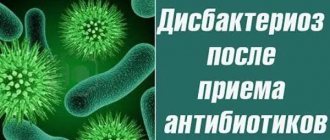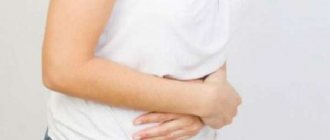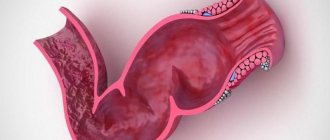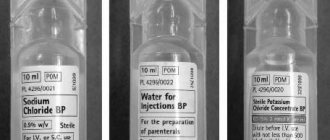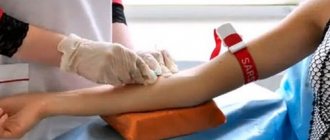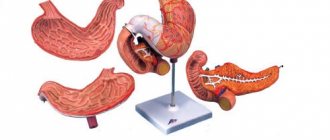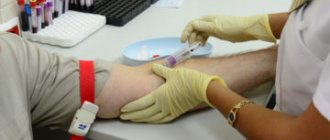Causes
Intestinal dysbiosis after antibiotics is not considered an independent disease by doctors.
Doctors perceive microflora disturbance as a concomitant phenomenon during antibacterial therapy. Causes of the disease:
- Disturbance of intestinal microflora.
- Death of beneficial microorganisms.
Signs of dysbiosis after taking antibiotics can also occur against the background of:
- Incorrect use of medications (violation of the regime).
- Self-prescribing medications.
- Exceeding the dosage.
Attention! Symptoms and treatment of the disease largely depend on the cause of its occurrence. If you do not follow the recommendations of a specialist, then digestive problems will not take long to occur.
The antibacterial drugs taken cannot act selectively; they affect all microorganisms. This leads to the death of beneficial microflora. As a result, digestive problems arise. To the extent that 2/3 of the beneficial microorganisms live in the human stomach, typical symptoms of dysbiosis occur.
Against the backdrop of a long course of the disease, problems with the immune system, weakness, and impaired liver and kidney function may appear.
The reasons for the development of dysbiosis are caused by medications that were used uncontrolled, with increasing doses, or were taken for quite a long time. If the medicine is of poor quality, it leads to damage to the mucous membrane and mercilessly kills beneficial organisms.
Often dysbacteriosis occurs at the time of a correct and carefully selected course of therapy.
The disorder may be caused by:
- disruption of the functioning of the digestive system;
- alcohol abuse;
- improper diet, heavy meals;
- acute intestinal pathologies;
- oncological diseases.
Intestinal dysbiosis: symptoms of intestinal microflora imbalance
Dysbacteriosis from taking various antibiotics
Intestinal disorders of the intestinal microflora are of a general nature. Most often, the functioning of the large intestine is disrupted, since this is where normal microflora lives. Remember that this part of the gastrointestinal tract is responsible for the absorption of water from the intestinal lumen, the formation of feces, the digestion of fiber, and the production of B vitamins by bacteria.
If most of the microflora has been destroyed, then this area will not be able to function normally. Due to this, patients may suffer from:
- Diarrhea (extremely with blood);
- Dehydration;
- Anemia of various origins (iron deficiency, etc.);
Video: drugs for dysbiosis
Often, impurities of undigested food residues (especially plant matter) may appear in the stool, which is due to an insufficient amount of enzymes secreted by bacteria.
Blood impurities in stool due to disruption of normal intestinal flora are extremely rare. If you notice this symptom, then most likely there is an ulcerated bleeding area in the intestinal wall. It can be caused either by pathological bacteria or other destructive phenomena.
Exposure to antibiotics
- Tetracycline drugs have a detrimental effect on the upper layer and mucous membrane of the intestine. Tetracyclines create favorable conditions for the introduction of pathogenic microorganisms. The number of staphylococci, yeast-like fungi and clostridia increases significantly. This pathological condition poses a serious threat, especially to the health of young children.
- Aminoglycosides inhibit the mechanism of protein synthesis of beneficial microorganisms, so the growth of indigenous microflora is suspended.
- Ampicillin affects both aerobic and anaerobic intestinal microflora. Beta-lactam drugs can cause antibiotic-associated diarrhea and pseudomembranous colitis due to the suppression of beneficial microflora and activation of C. difficile.
- Fungicidal antibiotics lead to selective proliferation of lactose-negative Escherichia coli.
The appearance of intestinal dysbiosis after antibiotics has characteristic signs and symptoms, it depends on which particular group of drugs affected the body:
- Tetracycline series - negatively affects the upper layer and walls of the intestine. Medicines provide a good environment for the invasion of pathogenic bacteria. The number of staphylococci, fungi, candida, and clostridia increases markedly. This pathological phenomenon is dangerous to health, especially for children.
- Ampicillin - affects aerobic and anaerobic flora. Beta-lactam medications can cause diarrhea, as well as pseudomembranous colitis.
- Aminoglycosides - suppress the effect of protein synthesis of the necessary organisms, because of this the growth of normal flora stops.
- Fungicidal - the number of Escherichia, Proteus bacteria increases.
Dysbacteriosis occurs equally in adults and children, even when antibiotics were prescribed based on tests and the person adhered to the correct dosage.
Classification of dysbacteriosis according to the content of microorganisms in feces
| Age | Stage | Laboratory indicators |
| Up to 50 years | Stage 1 | The indicator of typical Escherichia is underestimated to 105-106 or overestimated to 109-1010, the indicator of lactobacilli is underestimated to 105-106 and the indicator of bifidobacteria is underestimated to 106-107. |
| Stage 2 | The indicator of opportunistic bacteria is overestimated to 105-107, the indicator of bifidobacteria is underestimated to 107 and lactobacilli to 105. | |
| Stage 3 | The indicator of opportunistic microorganisms exceeds 107, the indicator of lactobacilli is reduced to 105, bifidobacteria - to 107. | |
| After 50 years | Stage 1 | The indicator of typical Escherichia went beyond 105-1010, the indicator of lactobacilli decreased to 104-105, bifidobacteria - to 106-107. |
| Stage 2 | The increase in the indicator of opportunistic microorganisms increases to 105-107, the indicator of lactobacilli decreases to 104, bifidobacteria - to 106. | |
| Stage 3 | The indicator of opportunistic microorganisms exceeds 106-107, the indicator of lactobacilli is reduced to 104, bifidobacteria - to 106. |
We suggest you read: How to treat chlamydia in pregnant women
Description of symptoms
Signs of a violation of the intestinal microflora are familiar to many; in most cases, patients complain of:
- stomach pain that occurs after eating;
- strong rumbling;
- disruption of the defecation process (constipation may occur, followed by diarrhea).
Dysbacteriosis after antibacterial drugs also leads to:
- to disruption of food absorption;
- increased gas formation in the stomach.
A person may complain of poor health, weakness, or general malaise. There is a tendency: dysbiosis is almost always combined with vitamin deficiency. This happens due to disruption of the absorption process of nutrients.
For this reason, you should take antibacterial medications only when indicated and without violating the dosage. Intestinal dysbiosis will have to be treated for quite a long time, since it will take time to restore the beneficial microflora.
Diet
When dysbiosis occurs after antibiotics, diet has a great influence on restoring healthy intestinal balance. Doctors recommend eating regularly, at least 4 times a day.
Products useful for dysbiosis:
- fresh vegetables and fruits;
- cereals (porridge, muesli, products with whole grains of wheat, rice, oats, etc.);
- bran (sold in pharmacies);
- fermented milk products: kefir, live yogurt, cottage cheese.
Baked goods and baked goods, fatty meats, hot spices, carbonated drinks, strong tea and coffee are harmful to the body.
Dysbacteriosis after antibiotics can be easily treated by adjusting the diet. However, this only applies to mild situations when there is no severe pain or malaise.
DETAILS: Cyforal antibiotic for cystitis
After taking an antimicrobial drug, you should choose foods that contain large amounts of fiber or indigestible fiber. These foods include all vegetables and fruits, herbs and whole grains.
For breakfast, it is preferable to eat porridge without sugar, cooked in water. For lunch, you can eat soups made from low-fat broth with a high content of vegetables or cereals. For dinner you can cook vegetable stew or boiled meat.
Try to give up bread, pastries and sweets. These products can cause increased fermentation in the intestines and, as a result, pain and discomfort. It is strictly forbidden to drink carbonated and alcohol-containing drinks.
To improve the functioning of the intestines and stomach, it is recommended to consume fermented milk products. These include sour cream, kefir, yoghurts without artificial additives and preservatives.
Nutritional therapy will help the intestines after antibiotic therapy. What are its features?
- You need to eat at least four times a day.
- Food should not be hot or cold.
- The amount of fermented milk products in the menu should be increased.
- All kinds of grains (rice, wheat, oats, etc.) are very useful.
- Fresh fruits and vegetables will help normalize microflora.
- It is good to use bran for dysbacteriosis.
But fatty and fried foods, smoked foods, hot spices, cakes, pastries, muffins, strong tea and coffee, carbonated drinks, and alcohol should be eliminated from the diet during the recovery period.
Correction of diet is a mandatory step in the treatment of DC. A special diet at the initial stage of pathology can completely eliminate the problem. The list of medications in this case will be minimal.
Harmful foods that can have a negative impact on the digestive system (causing flatulence, excessive gas formation, irritation of the mucous membranes, bloating, disruption of bowel movements and other gastrointestinal abnormalities) are completely excluded from the diet.
Proper nutrition is the most important component of preventing dysbiosis. With its help, the most common – first degree – intestinal dysbiosis is quite easily corrected.
Basic principles of the diet:
- dishes should be prepared only by cooking, steaming, stewing;
- Fatty, fried, salty, spicy foods are excluded from the diet;
- food is consumed 5-6 times a day;
- nutrition should be balanced, fractional;
- Alcohol is strictly prohibited;
- You cannot eat fresh vegetables and fruits;
- It is forbidden to introduce legumes, mushrooms, canned food, sausages, fatty meats and fish into the diet.
A diet for severe DC should be followed not only until the period of microflora restoration, but also for the purpose of prevention. It is not possible to eliminate a complicated form of pathology only by adjusting the diet.
Therapy is carried out by combining diet and special groups of drugs. The severe form of DC is in most cases accompanied by the development of vitamin deficiency and anemia. The patient's diet must contain a sufficient amount of vitamins and beneficial elements.
To replenish their supply, special vitamin complexes are additionally prescribed.
At home, there are several effective ways to treat intestinal dysbiosis in adults using diets. Food should be balanced, with the maximum amount of essential microelements.
You will have to exclude from the menu:
- alcohol;
- smoking;
- pickled and canned foods;
- fatty meats;
- fried food;
- fatty and concentrated broths and soups based on them;
- shortcrust pastry products;
- potato;
- pasta;
- refined sugar;
- mushrooms.
In addition, it is necessary to eliminate drinks and foods that contribute to gas formation:
- white porridge (from semolina, rice);
- baked goods;
- White bread;
- whole milk;
- sweets;
- grape;
- turnip;
- bananas;
- sweet apples;
- carbonated drinks (including mineral waters, sparkling wines), etc.
With the help of a well-chosen diet, intestinal motility is normalized. And, of course, we must remember that a therapeutic diet will require many restrictions, and be prepared for the fact that there are much more “don’ts” than “possibles” in it.
Clinical manifestations of dysbiosis
The clinical picture depends on the severity of pathological processes in the intestine. The following symptoms are characteristic of dysbiosis:
- excess gas content in the intestines, manifested by bloating and a feeling of discomfort in the abdominal cavity;
- frequent bowel movements accompanied by loose stools;
- difficult bowel movements;
- unpleasant burning sensations, irritation in the anal area;
- headache;
- feeling of discomfort in the epigastric region;
- change in color and consistency of stool.
In young children, these symptoms include sharp pain in the lower abdomen, increased body temperature, decreased appetite, and restless sleep. The question of how to treat dysbiosis after antibiotics in children should be approached with particular responsibility.
Diagnosis and consequences of dysbiosis
Treatment of intestinal dysbiosis in adults and children begins with diagnostic procedures. To prescribe effective drugs, it is often necessary to undergo a number of additional diagnostic procedures:
- Take a general blood test.
- Get your stool tested for culture.
- Take a breath test.
Important: Research is carried out if the doctor has certain doubts when making a diagnosis. And also if symptoms of dysbiosis were diagnosed in a child of the first year of life.
If a violation of the intestinal microflora is diagnosed not in an adult, but in an infant, then you should definitely consult a doctor. Because indigestion can have a detrimental effect on the baby’s health.
In such a situation, a doctor will help cure the imbalance, but it will take some time for the child to recover.
How to treat intestinal dysbiosis? There are several methods to help cope with the disease. Most often, therapy includes:
- taking various medications;
- treatment in adults also involves following a diet;
- giving up alcohol and smoking.
The question of how to treat a disorder of the intestinal microflora arises when the first signs of the disease appear. It is advisable that the medications be prescribed by a doctor, otherwise problems may arise.
What medications can be taken for dysbiosis after antibiotics:
- Probiotics and prebiotics.
- Vitamins.
- Drugs that inhibit the growth of pathogenic microorganisms in the intestines.
- Symbiotics.
- Combination medications.
- Synbiotics.
- Antiseptics
- Bacteriophages.
- Immunomodulators.
- Antibiotics.
Dysbacteriosis after antibiotics develops against the background of the death of beneficial microorganisms in the intestines. This leads to digestive problems and unpleasant symptoms. The use of prebiotics in therapy can be considered the best option; drugs of this class are not digested, creating a beneficial environment in the intestines and stomach for the growth and reproduction of microorganisms. Which helps to quickly restore natural balance.
Information: The therapeutic effect of the drugs appears gradually; recovery will take some time. For this reason, it is necessary to take medications regularly.
Good results are observed with a combination of probiotics and prebiotics. Probiotics include drugs that contain a complex of beneficial bacteria. Such medications will not be able to completely restore the intestinal microflora, but they can suppress the growth of pathogenic microorganisms. Normalize natural microflora.
Dysbiosis can also be treated with vitamins. Doctors recommend taking inexpensive vitamin complexes; they will come in handy. As a result of digestive disorders, problems arise with the absorption of food, the body lacks microelements and vitamins.
Intestinal dysbiosis in adults can be treated with the help of special medications that suppress the growth of pathogenic microflora. After taking antibacterial drugs, a favorable environment is created in the intestines and stomach for the growth and reproduction of pathogenic microflora.
Tablets for dysbacteriosis with a similar spectrum of action contain bacteria; they are not part of the natural microflora, but they help eliminate the manifestations of the disease and speed up the recovery process.
The use of symbiotics will help get rid of dysbiosis. You can ask your doctor which drug of this class is better. All medicines contain a number of beneficial microorganisms that help restore the natural microflora of the intestines and stomach.
How to cure dysbiosis using combination drugs? They should be consumed in accordance with doctor's recommendations. Both cheap and expensive drugs of this class may contain bacteria and substances that increase the activity of cells of the immune system.
Treatment of dysbiosis after the use of antibiotics can be carried out with the use of synbiotics; they contain useful cultures and substances that promote the development of beneficial microorganisms.
Attention! If severe dysbiosis develops, the help of medications is required, the action of which is aimed at suppressing the growth of pathogenic microorganisms. These medications are antiseptics.
Bacteriophages are specific viruses that infect bacteria and contribute to their death. The drugs are taken in the form of tablets and are also used for enemas.
When dysbiosis lasts for a long time after antibiotics, immunomodulators are prescribed. These are drugs that stimulate the body's natural protective functions. Taking them helps reduce the risk of developing infectious and viral diseases.
Treatment with antibiotics is carried out only in exceptional cases. When signs of pseudomembranous colitis appear.
The best effect is observed with complex therapy. When combining several medications, the effect can be achieved faster.
If dysbiosis is not treated in time, the following consequences are possible:
- the proper functioning of the intestines and stomach is disrupted, which leads to constipation or diarrhea, flatulence;
- ¾ of the immune system is supplied by intestinal microflora; if it is disrupted, the body becomes defenseless against bacteria and viruses;
- the production of certain hormones and vitamins is suspended;
- Minerals and vitamins are poorly absorbed, as a result of which the body weakens, and iron deficiency anemia is possible.
To avoid all this, you need to treat dysbiosis in time.
To confirm the pathology, the gastroenterologist will refer the person for examination and some tests:
- stool culture for dysbacteriosis;
- bacteriological examination of intestinal aspiration, biopsy;
- conducting a breath test;
- coprogram.
Destruction of microflora: consequences
Antibacterial drugs (antibiotics) can destroy pathogenic bacteria that cause inflammation of organs and tissues and intoxication when the body is affected by staphylococci, streptococci, pneumococci, etc. It is impossible to cure bacterial infections without the help of antibiotics. However, antibiotics do not have a selective effect, but destroy all microorganisms inhabiting the body indiscriminately. After antibiotics, dysbiosis requires long-term – at least a month – treatment.
What are the consequences of dysbiosis for the body?
- The absorption of vitamins and minerals deteriorates, resulting in a weakening of the body, and iron deficiency anemia may occur.
- ¾ of immunity is provided by intestinal microflora. After its destruction, the body remains defenseless against the viruses and bacteria around us.
- The normal functioning of the stomach and intestines is disrupted, which can manifest as flatulence, diarrhea or constipation.
- The production of certain vitamins and hormones stops.
Therapy of dysbacteriosis
The treatment regimen is determined by the reasons that caused intestinal dysfunction. A favorable rehabilitation prognosis is observed with complex therapy consisting of several stages:
- eliminating the imbalance between beneficial and opportunistic microflora;
- improving the transportation of digested substances from the cavity of the digestive tract to the lymph, blood and intercellular space;
- strengthening the body's defenses;
- stimulation of intestinal motility;
- restoration of the balance of microorganisms.
Drug therapy can eliminate symptoms, restore obligate intestinal microflora and correct a person’s immune status.
The suppression of facultative flora and normalization of microbial balance is facilitated by:
- Bacteriophages, or phages, are drugs that selectively destroy pathogens. They are non-toxic, so they can be used in the treatment of newborns. Bacteriophages penetrate the bacterial cell and multiply inside, which leads to its death.
- Prebiotics are components that are not absorbed in the upper gastrointestinal tract, but create favorable conditions for normal microflora, stimulating its vital activity and growth.
- Probiotics are medicines, dietary supplements, food products containing beneficial microcultures used for therapeutic purposes to restore indigenous flora.
- Enteroseptics (intestinal antiseptics) are prescribed for severe dysbacteriosis. This group of medications does not affect normal flora, but effectively fights pathogens. The antiprotozoal drug Intetrix® has proven itself well.
It is taken two capsules twice a day. The course of treatment is a maximum of five days. Visible improvements are observed after three days.
Nitrofurans are prescribed for the treatment of dysbiosis in adults. The course of treatment takes about a week. The dosage is 200 mg. The medicine is taken four times a day.
An effective alcohol antiseptic of plant origin is Chlorophyllipt®, which is pre-diluted in water.
- Immunomodulators of synthetic or natural origin. They regulate and stimulate the immune system, which reduces its protective functions when taking antibiotics. Natural immunomodulators include tinctures of Eleutherococcus, Echinacea and Schisandra.
- For a weakened body, vitamin complexes are recommended that replenish the deficiency of micro- and macroelements (Complivit®).
- Sorbents (Enterosgel®, Polysorb®) have a detoxifying, antidiarrheal and enveloping effect.
The decision on how to treat intestinal dysbiosis in adults after antibiotics is best made after consultation with a specialist.
Probiotics
Modern probiotics are placed in an innovative capsule that protects the ingredients from the acidic environment of gastric juice. The classification of probiotics is as follows:
- 1st generation - classic monoprobiotics containing 1 strain of bacteria;
- 2nd generation - bacteria that are nonspecific residents of the gastrointestinal tract (self-eliminating antagonists). They are immediately eliminated from the body;
- 3rd generation - multicomponent drugs consisting of several strains of bacteria. To enhance their effect, special additives are included in the composition;
- 4th generation – living microorganisms, representatives of obligate microflora. These include sorbed bifid-containing probiotics.
Prebiotics
Prebiotics are food components that are not digested by enzymes and promote the growth of beneficial bacteria, creating favorable conditions for their life.
They improve the condition of the body by stimulating the activity of certain microorganisms responsible for maintaining normal microflora.
How does a doctor choose a medicine?
Dysbacteriosis is treated with drugs with targeted action. The product is intended to kill exclusively pathogenic flora. The doctor does not prescribe medications arbitrarily. Before treating dysbacteriosis, a bacteriological study of the flora is carried out. In the laboratory, a culture is performed to identify the causative agent of the infection, and the resistance of the strain to certain antibiotics is checked. Similar to Fleming’s experiments a century ago.
The medicine that copes better with pathogenic flora than others is prescribed by a doctor. The doctor knows that an antibiotic is not the only component of complex therapy. At the same time, sorbents and probiotics are taken. The diet is adjusted.
Probiotics are an effective treatment. With the use of drugs, dysbacteriosis is prevented. Probiotic preparations contain microorganisms that form normal flora (lactobacillus, bifidobacteria). Selected ones are found in regular foods or dietary supplements. The above microorganisms inhibit the proliferation of pathogenic flora, strengthen the immune system, stimulate tissue regeneration, and restore the absorption of lipids and carbohydrates. The formation of vitamins begins and the sign of a gastrointestinal disorder in a person disappears.
Principles of nutrition
Main article: Nutritional considerations when taking antibiotics
Diet plays an important role in normalizing intestinal function. Nutrition should be balanced and healthy. Adjustment of the usual diet is necessary to eliminate the unpleasant symptoms that accompany the course of dysbiosis and introduce additional amounts of prebiotics. Prebiotics enter the body with food. They are found in large quantities in dairy products, bread, onions, beans, asparagus and bananas.
- It is necessary to completely eliminate alcoholic beverages, smoked meats, sausages, flour products, pasta, fatty meats, fried foods, and sugar. The diet depends on the clinical picture. If you have stool disorders (diarrhea), you should not eat foods that stimulate intestinal motor function.
- Vegetables and fruits that contain dietary fiber are prohibited. Potatoes, cereals and baked goods inhibit intestinal motility, which leads to difficult bowel movements.
- Carbonated drinks, grapes, sweets, semolina and rice porridge are undesirable, as they cause flatulence.
You need to eat at least five times a day. Portions should be small. How long dysbacteriosis lasts after antibiotics depends on compliance with these recommendations.
Diet for intestinal dysbiosis is of great importance. Compliance with nutritional rules will help you cope with the disease faster and reduce the severity of unpleasant symptoms.
What can you eat or nutrition for intestinal dysbiosis in adults:
- The diet must include fresh vegetables and fruits of good quality;
- It’s also worth preparing porridge from various cereals, oats, rice, wheat are suitable;
- you can eat muesli and bran;
- You should also include fermented milk products in your diet - yogurt, cottage cheese and kefir.
Important: It is recommended to eat in small portions, 4 times a day. Drink about 2 liters of clean water.
Folk remedies can also help enhance therapy; you can use tinctures and decoctions:
- Made from the bark of oak trees, they are rich in tannins and have an astringent effect.
- Partitions of walnuts, they help normalize stools and stop diarrhea.
- Dried blueberries help normalize intestinal function.
The remedy (decoction or infusion) can be prepared independently, at home. Patients cured of dysbiosis note that the effectiveness of folk remedies is low, but with complex treatment, the use of decoctions helps to strengthen traditional therapy.
It is difficult to say how long the treatment lasts and how long a person will be tormented by the main symptoms of dysbiosis. You will have to take medications for about a month. In some cases, longer therapy is required.
In women, taking antibacterial drugs may be accompanied not only by digestive problems, but also by disruption of the vaginal microflora.
Despite the fact that dysbiosis is not regarded by doctors as a serious disease, the consequences from it can be quite unpleasant: dehydration, loss of strength, weakness, etc. For this reason, from the moment you start taking antibiotics, it is worthwhile to prevent the disease, monitor your diet and strictly follow the doctor’s recommendations.
Features of therapy during pregnancy
For any disease, pregnancy is a risk factor for the use of many medications.
Medicines and herbs that are completely harmless at first glance can provoke an increase in the tone of the uterus, relaxation of the cervix, and cause spasms of the muscle tissue of the uterus, which is dangerous for spontaneous abortion and early labor.
Some medications can lead to delayed development of the embryo and fetus and have teratogenic properties, leading to intrauterine deformities.
In addition, any medications can provoke acute allergic reactions, including laryngeal edema and rapidly developing anaphylactic shock.
Since many pharmacological agents are used to treat dysbacteriosis, when expecting the birth of a baby, special attention is required to the contraindications set out in the instructions, which even the doctor is not always aware of.
Dangerous during pregnancy:
- Sumamed, Zitrolide (Azithromycin), Furadonin, Metronidazole, Trichopolum. Ciprofloxacin, Ciprolet, Nolitsin, Levomycetin, Biseptol, Ersefuril are prohibited;
- antispasmodics that contain bromine (Decitel) can cause neurological disorders in the fetus.
- laxatives for constipation Loperamide (Imodium), Senna;
- Among medicinal herbs and plants, the following are especially undesirable and even dangerous: tansy, wormwood, aralia, barberry, oregano, juniper, buckthorn, nutmeg, pennyroyal, celandine, lovage;
- products - garlic, rhubarb, radish, parsley.
We suggest you familiarize yourself with Treatment of potency Cyston is an antibiotic or not
An imbalance in microflora can be caused by various factors, among which long-term medication use ranks high. Signs of dysbiosis after antibiotic therapy are similar to those caused by other reasons. But the symptoms may vary in intensity depending on the severity of the microflora disorder.
Dysbacteriosis is conventionally divided into 4 stages, where 1 and 2 are considered mild forms, and 3-4 are considered severe. With strong immunity, stage 1 of the symptom complex lasts no more than 3 days and can go away on its own without drug treatment. The signs are not pronounced and do not appear intensified.
With an acute onset of dysbiosis, serious signs of microflora disturbance, the pathological process is classified as the last stages. Manifestations may bother the patient for 3-5 weeks.
Prevention of dysbacteriosis when taking antibiotics has special features. Dysbiosis is a symptom complex that can lead to serious complications if left untreated.
When dysbiosis develops due to the patient suffering from an infectious disease or diseases of the gastrointestinal tract, it is difficult to predict the appearance of unpleasant symptoms. And when undergoing a course of antibiotic treatment, you can avoid a malfunction in the microbial composition by adhering to certain rules:
- Therapy with antimicrobial agents should be carried out exclusively as prescribed by a doctor. Especially when it comes to children, women during pregnancy and lactation.
- Antibiotics should not be used for mild infectious diseases or colds.
- Medicines have varying degrees of effects. The drugs must correspond to the severity of the disease; unreasonably strong antibiotics should not be used for mild forms of the pathology.
- During antibiotic therapy, it is important to simultaneously take probiotics and prebiotics or symbiotics - combined preparations containing several strains of beneficial bacteria and components that serve as food for them.
- The duration of medication should significantly exceed the duration of antibiotic treatment. The minimum duration of probiotic use should be 1 month.
- Diet plays an important role in treatment or prevention. The diet includes fermented milk products, fruits, vegetables, cereals, and bran.
Preventive measures
Individual selection of an antibacterial drug, proper nutrition, proper rest, timely contact with a gastroenterologist at the first symptoms, compliance with sanitary and epidemiological rules, etc. will help prevent the development of microbial imbalance.
A fractional nutrition system, which is actively promoted by nutritionists, has a beneficial effect on the state of the gastrointestinal tract. This approach helps reduce the burden on the gastrointestinal tract. Frequent meals not only normalize digestion, but also promote weight loss. Avoid late meals; your last meal should be 3 hours before bedtime.
Antibacterial drugs
Broad-spectrum antibiotics are prescribed in cases where an excess of pathogenic microflora in the intestine has caused malabsorption and led to digestive disorders, as well as in the development of infectious inflammatory diseases of the gastrointestinal tract.
In the most severe cases, preference is given to antibiotics from the tetracycline series, penicillins, cephalosporins and fluoroquinolones. In milder situations, a specialist may prescribe antimicrobial agents that have a bactericidal effect in the intestinal lumen (Furazolidone).
The standard course of such therapy does not exceed 7–10 days. After finishing taking antibiotics or antimicrobial drugs, adults are recommended to take sorbents (Enterosgel, Polyphepan) to cleanse the intestines of dead bacteria and their waste products.
When treating dysbiosis caused by taking antibiotics, the main principle is the prevention of dysbiosis - the rational use of antibiotics: in no case should you drink them unreasonably.
Treatment of dysbiosis after antibiotics
The main method for diagnosing dysbacteriosis is bacteriological examination of stool or vaginal smear (bacteriological culture). It helps determine which bacteria have multiplied in what proportions in the intestinal flora after taking antibiotics. Sometimes (in rare cases) additional examinations may be prescribed - contrast X-ray, colonoscopy, sigmoidoscopy.
Treatment of dysbiosis after antibiotics in adults and children is aimed at normalizing the composition of the intestinal (or vaginal) microflora. The task is achieved by combining two methods - following dietary recommendations and taking special antiseptic drugs that suppress the growth of pathogenic and opportunistic flora without destroying the beneficial one.
Drugs
| Type of pathogenic microorganisms | Antibiotic, its pharmacological group | Dysbacteriosis drug | Mechanism of action | Directions for use and dosage |
| Staphylococcus | Oleandomycin (macrolides) | Polysorb | Enterosorbent with detoxification, adaptogenic and adsorbent effects | 100-200 mg/kg, 4 times a day, course duration – 2-3 weeks |
| Enterococcus | Amoxicillin (semi-synthetic penicillins | Colibacterin | Inhibition of the reproduction of pathogenic and opportunistic microflora | Dosage: the contents of one bottle are diluted with 100 ml of water, number of doses – 3-4 times/day, for 10-14 days |
| Escherichia coli | Furacilin (nitrofurans) | Bifiform | Probiotic | 2-3 capsules per day, course – 10-21 days |
| Escherichia coli | Phthalazole (sulfonamide) | Hilak forte | Prebiotic | 40-60 drops 3 times a day, for 10-14 days |
| Escherichia coli | Nevigramone (nalidixic acid) (quinolones) | Duphalac | Prebiotic | 15-40 ml, 2-3 times/day, 7-14 days |
| Pseudomonas aeruginosa | Polymyxin (cyclic polypeptides) | Bificol | Lyophilisate powder with antagonistic properties against pathogenic microflora | One ampoule or one bottle 5 times a day for 10-14 days |
| Pseudomonas aeruginosa | Kanamycin (aminoglycosides) | Trimedat | Antispasmodic, improves intestinal motility, regulates peristalsis processes | 100 mg three times a day, course of treatment is 7-10 days |
| Candidomycosis | Lamisil (antimycotics) | Lactobacterin | Dried mass of dry lactobacilli that produce lactic acid and are active against pathogenic flora | 5 doses, half an hour before meals, 2-3 times a day, course duration – 7-10 days |
| Candidomycosis | Amphotericin (macrocyclic antibiotic) | Linex | Contains three types of lactic acid bacteria that normalize the state of microflora | 2 tablets, 3 times/day, 10-12 days |
| Proteus, Pseudomonas, staphylococcal infection | Bacteriophages (viruses) | Iberogast | A product based on herbal components, normalizes motor skills, regulates processes associated with microflora imbalance | 20 drops, 3 times a day, 12-20 days |
Treatment of the intestines after taking antibiotics necessarily includes following a special diet. It is important to include fermented milk products, cereals, vegetables and fruits containing dietary fiber, and foods with amino acids in your diet. To maintain vital activity and reproduce beneficial intestinal flora during dysbacteriosis, polysaccharides and olisaccharides, which are included in the following products, are important:
- apples;
- bananas;
- apricots
- berries;
- carrot;
- zucchini;
- onion garlic;
- oatmeal and other grains.
The choice of diet depends on the severity of the symptoms of a particular clinical case. For constipation and increased gas formation, the menu includes foods that activate intestinal motility (meat, dairy proteins, pickled or pickled vegetables, cereals), and excludes foods that provoke fermentation processes (legumes, cottage cheese, nuts, cabbage).
Normal microflora is extremely important for the good functioning of the intestines, which also helps maintain the high-quality functioning of all systems of the human body. What role does it play? Hundreds of microorganisms live in the gastrointestinal tract, some of them are useful - bifidobacteria, lactobacilli. Others, on the contrary, are opportunistic - these include Escherichia coli, yeast-like fungi, and enterococci. Taking antibiotics provokes an imbalance between these representatives of the microflora.
Heavy drugs used for treatment destroy harmful bacteria, but their action cannot be aimed exclusively at pathogenic microorganisms. Along with the rest, antibiotics affect beneficial bifidobacteria and lactobacilli. What do these representatives of the microflora do in the normal state of the gastrointestinal tract:
- They are an obstacle to decay processes, since they promote the release of lysozyme, acids, and alcohols. They help neutralize toxic substances resulting from the activity of pathogenic microorganisms.
- Helps break down proteins and acids.
- Actively participate in fat metabolism.
- Absorb through the intestinal walls elements and substances necessary for the healthy functioning of the body.
- They provide the release of immunoglobulin A, which significantly improves the protective functions of the immune system.
When the activity of the good inhabitants of the microflora becomes less active, a person begins to feel unpleasant symptoms: abdominal pain, rumbling, abnormal bowel movements (constipation or diarrhea), deterioration of skin condition, the appearance of eczema, fatigue, rash, allergies. This is how dysbiosis in the body is expressed. This disease can cause serious hormonal disorders, can cause a decrease in immunity, and disruption of the functioning of many internal organs.
Restoring the microflora of the intestinal and gastric mucosa is an event inseparable from taking antibiotics. Without proper attention to this issue, the human body can suffer many unpleasant changes.
Proper nutrition, giving up bad habits, eating special foods - all this must become part of the lifestyle after treatment with antibiotics.
To speed up the recovery process, you need to see a gastroenterologist who will conduct individual therapy.
Giving up bad habits is the first thing a person should take care of. Cigarette smoke can severely irritate the gastric mucosa, and drinking alcohol after taking antibiotics is strictly prohibited. This is due to the fact that the drugs reduce the protective functions of the liver; the organ will not be able to quickly and effectively process harmful substances that enter there. At the same time, it is advisable to devote time to physical exercise, it helps to increase immunity, and it is important to provide the body with good rest.
Establishing a proper diet is an important step that helps speed up the process of the intestinal microflora returning to normal after taking antibiotics. Eating healthy, nutritious food will have a positive effect on the general condition of the human body and improve metabolism. What rules should you follow when maintaining proper nutrition to restore intestinal microflora:
- Avoid fatty, fried, heavy foods, which can worsen the symptoms of dysbiosis. Give preference to dietary products.
- If constipation is a concern if the microflora is disturbed, eat foods that have a laxative effect: freshly squeezed juices, bran, prunes, beets, oatmeal, fruits and vegetables.
- Avoid legumes, cabbage, grapes, pears, bread, and dairy products to avoid flatulence.
- Eat the following vegetables and fruits: boiled cauliflower, carrots, zucchini, baked apples.
- Make bone broths. This dish contains a beneficial substance - glutamine, which helps restore the liver.
In addition to a proper, balanced diet, fermented milk products help to significantly improve the condition of the intestinal microflora after taking antibiotics. These are kefir, feta cheese, whey, special kefir “Bifidok”, “bio-kefir”, “Bifilife”, “Acidobifilin”, and “Actimel” products. Their use promotes rapid cleansing of the intestine, increased lactation, and restoration processes of intestinal cells.
Preparations containing enzymes that help improve the functioning of the digestive system, making it much easier to restore the intestinal microflora. These include Mezim Forte, Creon, Pancreatin, Duphalac. However, after taking antibiotics, you should not immediately run to the pharmacy to get them. It is necessary to consult a doctor to prescribe the correct therapy.
To restore the intestinal microflora, special dietary supplements have been developed in tablets containing probiotics or prebiotics. Depending on the composition, the effect of this medicine on the body changes. How do these two groups of drugs differ from each other and how do they affect the intestines after taking antibiotics:
- Probiotics (Enterozermina, Bifiform, Acylact, Linex) contain bacteria that help maintain the normal state of microflora.
- Prebiotics (“Stimbifid”, “Lactusana”, “Prelax”) contain substances (special plant fibers) that stimulate the formation of one’s own bifidobacteria and lactobacilli in the intestines.
Doctors usually prescribe probiotics for a long time. The intestinal microflora after taking antibiotics is restored in about six to eight months.
Prebiotics are prescribed if there are enough bacteria in the intestinal tract, then the medications stimulate an increase in their number, the effect is noticeable after two weeks of use.
Prebiotic agents are not prescribed in cases where the beneficial microflora is almost completely destroyed.
Another assistant in the fight against dysbiosis after taking antibiotics is folk remedies that help restore the microflora, approved by doctors of modern medicine. Some products contain many useful substances that help quickly get rid of the unpleasant symptoms of bacterial imbalance in the intestines and increase the number of beneficial lacto- and bifidobacteria. Several folk recipes to improve the condition of microflora:
- Sunflower seeds, pumpkin seeds and walnut kernels. Take 10 grams of all ingredients. Grind them with a coffee grinder, pour boiled water (100 grams). Let the mixture brew properly. This is a serving for the day, half of which should be drunk in the morning, the other half in the evening. Course - 10 days. The mixture helps to more actively restore intestinal microflora.
- Compotes and fruit drinks from berries. Raspberries, currant compotes, blueberry fruit drinks will help with diarrhea, help improve metabolism, and speed up digestion. You can drink one or two glasses a day. It is advisable to cook without sugar.
- Dill water. Take a teaspoon of dill seeds, add hot water (100 grams), let it brew for an hour. Filter. Take a teaspoon three times a day. Water helps reduce flatulence.
- Herbal infusions. For diarrhea caused by disturbances in the intestinal microflora, an infusion of cinquefoil will be effective. To do this, boil a tablespoon of herb for about fifteen minutes, leave for 12:00. Gives an anti-inflammatory effect.
- Sauerkraut. This product is a source of fermented substances, and therefore daily consumption of it in small quantities will help restore the intestinal microflora.
- Beet juice. Taking antibiotics, especially long-term, causes a decrease in the number of blood cells - red blood cells. Beetroot juice will help restore them and improve blood circulation.
- Tea mushroom. Infused for at least four days, drink a glass three to four times a day before meals. The course is six to eight weeks. The product will help restore the intestinal microflora faster.
- Fresh garlic. Finely chop one head and place in a glass jar. Pour in 250 ml of sunflower oil. After a day, start eating the mixture: add to salads, porridge. Garlic oil will speed up the formation of beneficial bacteria.
- Propolis. Mix a teaspoon of honey with propolis, dissolve in warm water (250 ml). Take a glass every day for six weeks to restore intestinal microflora. Propolis is a natural antibiotic and restores the immune system well.
doctors' recommendations
- Avoid nicotine, alcohol, fried, fatty, salty, spicy and heavy foods.
- To restore microflora and not harm yourself, take medications only after examination by a doctor, who can perform a colonoscopy to evaluate the condition of the intestines.
- After taking the antibiotic ceftriaxone, medications such as Vivasan and Hilak Forte help improve the intestinal microflora.
- After taking the antibiotic “ofloxin”, you should definitely take a course of “Linex” for intestinal microflora.
- Antibiotic treatment for intestinal dysbiosis symptoms in adults
- Treatment of the intestines after taking antibiotics in adults
- Diet after antibiotics for adults
- Maxilak after taking antibiotics
Probiotics
Probiotics are drugs for the effective treatment of intestinal dysbiosis; they contain microorganisms that have a positive effect on the intestinal microflora. In order for the microorganism to pass through the upper parts of the digestive tract with minimal losses, it is placed in an acid-sensitive capsule.
All probiotics can be divided into several groups:
- Monocomponent. They consist of one type of bacteria - bifidobacteria, lactobacilli, colibacteria - Bifidumbacterin, Lactobacterin, Colibacterin.
- Multicomponent. They contain several types of bacteria, colibacteria, bifidumbacteria, lactobacilli - these are Linex, Bifiform, Bifikol.
- Combined. They contain symbiotic communities of major bacteria and strains that are resistant to most antibiotics in combination with a nutrient medium and immunoglobulin complexes. Linex, Rioflora immuno, Bificol.
- Synbiotics. These medicines are produced with a competent combination of pre- and probiotics, forming ready-made complex medicines, for example, Bifidobac, Maltodophilus, Laminolact.
- Antagonists. Probiotics can conditionally be classified as antagonists; these are microorganisms that can also suppress the development of opportunistic flora; these include antidiarrheal drugs such as Enterol, Bactisporin, Baktisubtil.
It is worth understanding that in severe forms of dysbacteriosis, the use of probiotics and prebiotics alone is not enough; additional use of antibacterial agents and intestinal antiseptics is also necessary.

